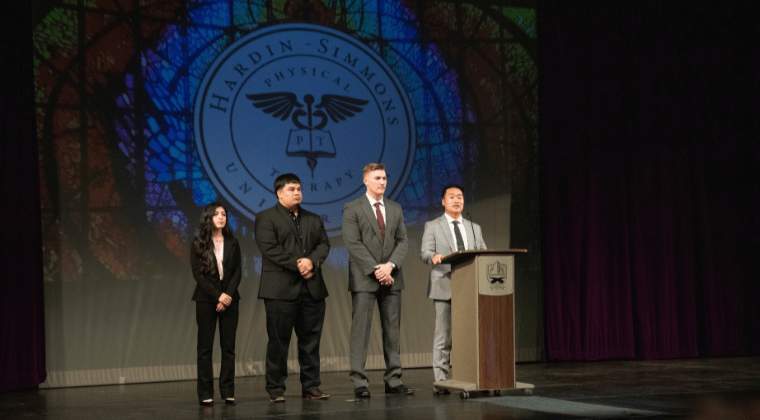Research that Impacts: Exploring Artificial Intelligence, Strength in Grunting, the Human Side of Mentorship, and Strength Assessment in Home Health
Part One: The Doctor of Physical Therapy 29th Annual Scientific Inquiry Event
At Hardin-Simmons University, the Doctor of Physical Therapy (DPT) program is a dynamic, hands-on degree program that extends beyond textbooks and lectures, shaping the future of healthcare. Students aren’t just learning; they’re discovering, innovating, and shaping the field of physical therapy with research that has real-world impact.
Each year, the graduating class presents a year of dedicated research at the Annual Scientific Inquiries in Physical Therapy Practice event. This milestone marks the culmination of their academic journey before embarking on clinical rotations. Guided by expert faculty, students conduct in-depth research and showcase their findings, demonstrating their readiness to advance the field of physical therapy.
Step into the lab and into the minds of these trailblazing students as they explore groundbreaking concepts and push the boundaries of patient care.

Reimagining Physical Therapy with Artificial Intelligence – Jonathan Hoerman ’25 | Fredericksburg, Texas
Abilene recently made headlines as the launch site for the largest AI infrastructure project in U.S. history, but what does artificial intelligence have to do with physical therapy?
Jonathan Hoerman, a second-year DPT student from Fredericksburg, Texas, and his team were tasked with discovering the perceptions of generations of physical therapists regarding AI. Their research dives into how clinicians view artificial intelligence—some with excitement, others with skepticism. They found that younger professionals see AI as an ally, helping to streamline diagnostics and personalize treatment plans, while older clinicians worry about reliability and job displacement.
Understanding these perspectives is the key to integrating AI in a way that benefits both practitioners and patients.
The Power of a Grunt: Strength in Sound – Amani Bradshaw ’25 | Killen, Texas
Amani Bradshaw, a second-year DPT student from Killeen, Texas, found her group research project on grunting particularly meaningful due to her aspirations of working with the geriatric population.
“Our findings will be valuable for patients who have experienced strength loss and need to increase force output to regain functional independence,” Amani shared.
Inspired by the work of Dr. Dennis O’Connell, a professor of physical therapy in the College of Health Professions who has extensively explored the effects of grunting on various functional activities in older adults, students were motivated to investigate more of grunting’s benefits.
“I can see our research being applied practically in sports that require a high amount of force, power, and velocity, such as tennis and baseball,” shared Amani. “Grunting can improve strength, independence, and performance in individuals with physical limitations.”
As Amani reflected on her journey, it was clear that their research had equipped her with valuable skills and insights to carry forward into her career.
“Before joining this program, I had never conducted research, so I was excited to engage in the process for the first time,” said Amani. “Presenting our results to my family and friends made the experience even that much more rewarding and special.”
Personalities in the Clinic: The Human Side of Mentorship – Richard (RJ) Sherrow ’25 | Richmond, Texas
The investigation into the role of personality profiling in clinical supervision began with a spark of inspiration from an experienced mentor.
Dr. Beth Schaeffer, a research advisor known for her dedication to understanding the perspectives of clinical instructors, had been gathering data on her experiences for several years. This year, however, the research group set out to broaden the scope by including students in their study, aiming to gather fresh insights from those directly impacted by clinical supervision.
“I became interested in this topic because of Dr. Schaeffer’s ongoing research,” shared Richard (RJ) Sherrow, a student from Richmond, Texas. “She had been focusing on clinical instructors, and this year we decided to add the student perspective. I was excited to see how personality profiling might influence the mentorship dynamic.”
Traditionally, clinical instructors in physical therapy mentor students based on their personal experiences and teaching preferences. This approach, though rooted in real-world experience, does not always consider the varied ways students learn and interact.
“Without personality profiling, instructors teach based on what works for them, but it may not always be effective for every student. There’s a chance we’re not maximizing the potential of each rotation by overlooking how individual personalities impact learning,” explained RJ.
With a “blue/gold” personality profile from the True Colors assessment, RJ shared that he is naturally drawn to caring, compassionate, and nurturing connections. These traits helped him personally on his three-week clinical rotation in August with his clinical instructor.
“My instructor recognized that I genuinely wanted to do my best—not only for myself but for him and his patients. I believe my caring nature helped build trust and fostered better communication and patient care,” RJ explained.
RJ shared his team’s research of integrating personality profiling into clinical training holds the potential to enhance communication, teamwork, and overall effectiveness.
“I truly do believe scientific inquiries and research in general help with recruiting because all it takes is just one person’s interest to be sparked,” shared RJ when asked if he thought this opportunity helps with recruitment. “That one spark could provide so much more knowledge and education for the profession!”
Bringing Strength Testing to Every Home – Dan Tagailo ’25 | Houston, Texas
In the world of home healthcare, where clinicians face unique challenges in assessing and monitoring patient progress, a new tool is emerging as a game-changer—the handheld dynamometer (HHD). However, recent research from the Hardin-Simmons University DPT program suggests that this device, which measures muscle strength, may be just as, or more effective than traditional methods, with the added benefits of portability, ease of use, and efficiency.
“Our research showed that the hand-held dynamometer is able to measure a one repetition maximum (1RM) as accurately as traditional dumbbell methods,” explains Dan Tagailo, a student researcher in the Hardin-Simmons DPT program from Houston, Texas. “But unlike dumbbells, the HHD is portable, time-efficient, and much easier to use, which makes it an excellent tool for home health clinicians.”
In the traditional method, physical therapists rely on dumbbells of varying weights to measure a patient’s muscle strength. The process can be cumbersome, especially in home settings where a full set of weights may not be available. For home health clinicians, this limitation is a significant challenge when it comes to obtaining a reliable baseline for muscle strength and tracking progress over time.
“Home health clinicians are often limited to what they can carry or what the patient has available,” Dan continues. “A full rack of dumbbells is usually not an option, making it difficult to accurately assess a patient’s one repetition maximum. That’s where the hand-held dynamometer comes in—it’s compact and portable, which allows clinicians to assess strength no matter the setting.”
Surprised by how reliable the hand-held dynamometer was for predicting 1RM, Dan explained their research is particularly crucial for rural healthcare, where clinicians often travel long distances to reach patients, and transporting large equipment can be a challenge.
“With the HHD, clinicians can establish a baseline for exercise and track progress more effectively throughout the course of treatment,” Dan adds. “As patients get stronger, the HHD allows therapists to monitor improvements in muscle strength, which ultimately leads to better-targeted care and outcomes.”
This research is helping pave the way for the future of muscle strength assessment in home health, offering a promising solution that could benefit both clinicians and patients alike.


